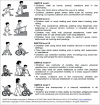Physical therapy guideline for children with malnutrition in low income countries: clinical commentary
- PMID: 27656622
- PMCID: PMC5031388
- DOI: 10.12965/jer.1632674.337
Physical therapy guideline for children with malnutrition in low income countries: clinical commentary
Abstract
Physical therapy intervention along with nutritional rehabilitation has recently become an inevitable combo after recent evidences suggesting a strong interaction between malnutrition and neuro-muscular disabilities which contribute to a significant burden in global settings. Recent studies confirm that appropriate physical assessment of neuro-musculo skeletal system, developmental assessment or cognitive tools along with nutritional assessments followed by exercise rehabilitation will yield positive results in children with malnutrition. There is an obvious need to make available a simple physical therapy exercise guidelines with simple measure and exercise to be used in resource limited settings of developing countries. The purpose of this clinical commentary is to summarize simple assessment tools to evaluate activity impairment, participation restriction, gross motor activity and simple physical therapy intervention program for children with disability secondary to malnutrition.
Keywords: Exercise; Malnutrition; Physical therapy; Play therapy.
Figures
References
-
- Aly Z, Taj F, Ibrahim S. Missed opportunities in surveillance and screening systems to detect developmental delay: a developing country perspective. Brain Dev. 2010;32:90–97. - PubMed
-
- Andrew MJ, Sullivan PB. Feeding difficulties in disabled children. Paediatr Child Health. 2010;20:321–326.
-
- da Campos LSK, Neumann LD, Rabito EI, de Mello ED, Vallandro JP. Nutritional risk assessment in hospitalized children: a comparison of pediatric subjective global assessment and STRONGkids screening tool with anthropometric indicators. Sci Medica. 2016;25:21948.
Publication types
LinkOut - more resources
Full Text Sources
Other Literature Sources


